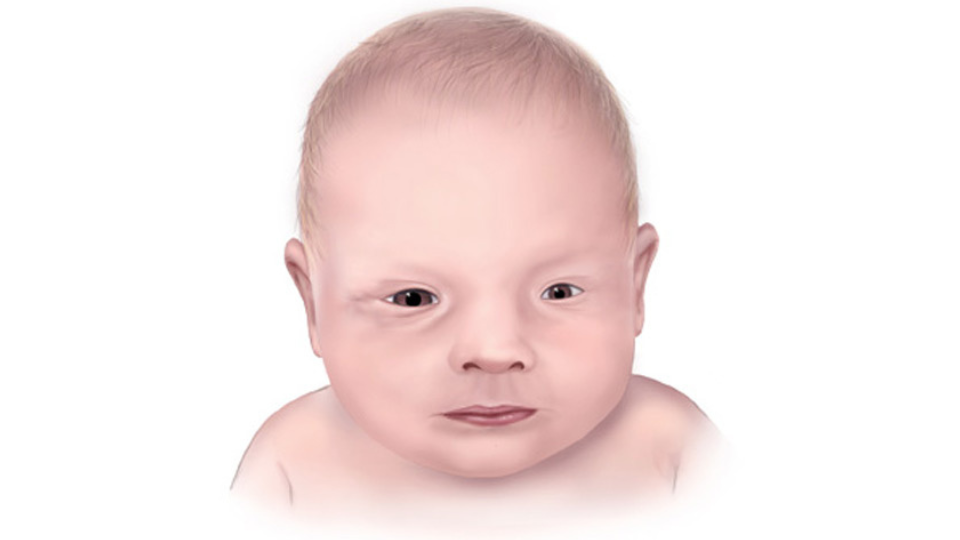Bilateral Anophthalmia In Babies: Causes, Diagnosis, And Support

Table of Contents
Understanding Bilateral Anophthalmia
Bilateral anophthalmia refers to the congenital absence of both eyes. It's crucial to differentiate this from anophthalmia (absence of one eye) and microphthalmia (abnormally small eyes). The severity of bilateral anophthalmia can vary; some individuals may have completely absent eye structures, while others might have rudimentary remnants.
Key characteristics of bilateral anophthalmia include:
- Complete absence of eyeballs: Both eye sockets are empty.
- Associated conditions: Bilateral anophthalmia is sometimes associated with other developmental abnormalities, such as cleft palate, hearing loss, and cardiac defects.
- Impact on daily life: The lack of eyesight necessitates the use of alternative sensory inputs and adaptive technologies to navigate daily life.
Causes of Bilateral Anophthalmia
The etiology of bilateral anophthalmia is complex and often multifactorial. Genetic factors play a significant role, with several genes and syndromes linked to the condition. Mutations in genes involved in eye development, such as PAX6, SOX2, and OTX2, have been implicated. Additionally, chromosomal abnormalities, like trisomy 13 and trisomy 18, are sometimes associated with bilateral anophthalmia.
Environmental factors may also contribute. Exposure to certain teratogens during pregnancy, including some medications and infections, can disrupt normal eye development. Maintaining optimal prenatal care, including avoiding exposure to known teratogens, is crucial.
Potential causes of bilateral anophthalmia include:
- Genetic mutations: PAX6, SOX2, OTX2, and other genes related to eye development.
- Chromosomal abnormalities: Trisomy 13 (Patau syndrome), trisomy 18 (Edwards syndrome), and others.
- Exposure to teratogens: Certain medications, infections (e.g., rubella), and environmental toxins during pregnancy.
- Unknown causes: In many cases, the underlying cause of bilateral anophthalmia remains unidentified.
Diagnosis and Screening
Early diagnosis of bilateral anophthalmia is critical for initiating appropriate interventions and support. Prenatal diagnosis is possible through ultrasound scans, which can reveal the absence of eyeballs in the fetal eye sockets. Genetic testing, including karyotyping and gene sequencing, may be performed to identify underlying genetic causes.
Postnatal diagnosis is typically made through a thorough physical examination by an ophthalmologist. The absence of eyes in both orbits is a clear indicator of bilateral anophthalmia. Further genetic investigations might be necessary to determine the cause and assess the risk of recurrence in future pregnancies.
Diagnostic steps typically include:
- Prenatal ultrasound scans: To detect the absence of eyeballs during pregnancy.
- Genetic testing: Karyotyping, chromosomal microarray analysis, and gene sequencing to identify underlying genetic abnormalities.
- Postnatal physical examination: By an ophthalmologist to confirm the diagnosis.
- Further genetic investigations: If necessary, to determine the precise genetic cause.
Support and Treatment Options for Bilateral Anophthalmia
Providing comprehensive support to families affected by bilateral anophthalmia is paramount. This involves emotional and psychological support for parents, coping mechanisms, and guidance on managing daily life with a visually impaired child. Early intervention is crucial, particularly regarding the fitting of ocular prostheses (artificial eyes). These prostheses improve the child's appearance and can help with social integration.
Other supportive therapies and assistive technologies are vital. Vision rehabilitation specialists can assist with developing alternative sensory skills and adaptive techniques. Braille instruction, adaptive equipment, and assistive technologies are essential for promoting independence and participation in educational and social settings.
Living with Bilateral Anophthalmia
Living with bilateral anophthalmia presents unique challenges but with appropriate support, children can thrive. Parents play a crucial role in fostering a positive self-image and independence. Creating a supportive educational environment is critical, ensuring access to appropriate resources and inclusive learning strategies. Connecting with support groups and organizations provides invaluable emotional support and shared experiences.
Conclusion
Bilateral anophthalmia, while a rare condition, necessitates prompt diagnosis and comprehensive support. Understanding the genetic and environmental factors associated with this condition is crucial for providing appropriate care and guidance to affected families. Early intervention, including fitting of ocular prostheses and access to vision rehabilitation specialists, is essential for optimizing the child’s development and quality of life. Numerous support systems and resources are available to help families cope with the challenges of bilateral anophthalmia. If you have concerns about your child's eye development or suspect bilateral anophthalmia, consult a medical professional immediately. Learn more about bilateral anophthalmia support and resources to ensure your child receives the best possible care.

Featured Posts
-
 Cavs Vs Knicks Expert Picks And Betting Odds For February 21
May 12, 2025
Cavs Vs Knicks Expert Picks And Betting Odds For February 21
May 12, 2025 -
 Knicks Resilience Shines Through In Overtime Win Over Bulls
May 12, 2025
Knicks Resilience Shines Through In Overtime Win Over Bulls
May 12, 2025 -
 Bilateral Anophthalmia In Babies Causes Diagnosis And Support
May 12, 2025
Bilateral Anophthalmia In Babies Causes Diagnosis And Support
May 12, 2025 -
 Yankees Brewers Series Checking The Injured List March 27 30
May 12, 2025
Yankees Brewers Series Checking The Injured List March 27 30
May 12, 2025 -
 A Crazy Rich Asians Tv Series Is Coming Heres What To Expect
May 12, 2025
A Crazy Rich Asians Tv Series Is Coming Heres What To Expect
May 12, 2025
